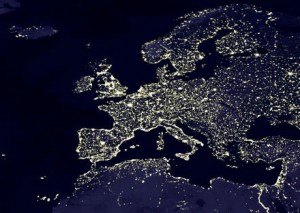 The United States’ transportation and water infrastructure—its highways, airports, water supply systems, wastewater treatment plants, and other facilities play a pivotal role in the economy.
The United States’ transportation and water infrastructure—its highways, airports, water supply systems, wastewater treatment plants, and other facilities play a pivotal role in the economy.
But how should they be paid for?
In a recent MarketWatch opinion article Christopher Hinton suggests higher taxes as the way to pay for the crumbling infrastructure in the United States. The article’s key economic summary paragraph: “Today U.S. infrastructure investments amount to 2.4% of the nation’s GDP, versus 5% in Europe and 9% in China…” Falling revenue from federal taxes, including those on gasoline sales, are restricting the budgets that would otherwise be used to shore up systems.
He cites a widely discussed 2007 report from the US Department of Transportation that found declining highway expenditure budgets led to lower employment across many sectors of the economy. For every $1 billion lost from the national highway budget, an estimated 30,000 jobs are lost in steel, construction, concrete and paving firms. Even those who found fault with that report’s details agreed with the overall picture presented there. It is clear that spending less on infrastructure means fewer jobs, and not just for paving contractors.
The newest report on infrastructure spending in the US is from the Congressional Budget Office (CBO). It suggests increased spending on transportation and water infrastructure through tax increases and a mix of anti-fraud and cost-savings measures on spending programs already in place.
The recent CBO report is being used by the Obama administration to push for the establishment of an infrastructure bank. This is a special funding organization that would serve as a clearinghouse for public funding, bond ventures and other debt instruments that could be used to increase funds available for projects.
These solutions are attempts to solve a brutally basic three-sided problem. The infrastructure in the United States is crumbling and in need of repair (and expansion) while the costs of infrastructural systems and materials are rising and funds available to support the work are shrinking. Public funding, from tax revenues, is restricted as the economy languishes and credit remains tight.
But is public funding the only way to solve this problem?
Today the public funding model is so widespread, from massive Chinese state-funded mega-projects to small town local street repairs that it seems to be the only solution. But that doesn’t tell the whole story. Infrastructure funding in the US, and many Western countries, began with primarily private funds. Bond funding, stock companies and even lotteries were used to build canals, turnpikes and other infrastructure projects in the previous two centuries.
Recent examples of private investment replacing public funding can be found in public-private partnerships where cities and states have sold off infrastructural systems. In 2005 Chicago sold the southern tollroad into the city, the Chicago Skyway, to Skyway Concession Company, LLC for $1.83 billion, Skyway Concession has a 99 year lease to operated and maintain the road. In nearby Indiana the state sold lease rights to a tollroad that runs across the northern tier of the state.
In October 2008, in a similar deal, Chicago tried to lease the rights to Midway Airport for $2.5 billion but funding for the deal fell through. The recession has stopped the rollout of more deals but the benefits are obvious. Selling off large infrastructural systems provides cities and states with revenue and frees them from having to maintain a budget for upkeep and repair. The investors hope to make a profit from fees and rents they will charge users rather than taxes.
This solution, suggested by many in and outside of government, is promoted by the National Association of Public and Private Partnerships, among others. These types of partnerships make up almost 7 percent of funding for infrastructure projects in the UK and Australia.
So what stands in the way of the expansion of private funding for infrastructure projects? Infrastructures, by their very nature, require large ‘footprints’ in terms of land, access to other services and infrastructure and require large scale investments. Building a road, railroad, dam or airport in the United States also requires permits and regulatory agreements at every level of government in an often byzantine pattern of overlapping authority. Federal and state agencies have regulatory control over large aspects of the economy that smaller ventures do not require. In some cases it is easier to start an international company, even a bank, than it would be to build a road from one town to the next.
Another key aspect difficulty with private infrastructure funding are the incentive structures currently in place. Firms led by even the most ardent anti-government libertarian will still feel compelled to engage in bidding and lobbying for contracts when huge amounts of federal funding can provide lucrative long-term contracts. Many cities have put local regulations in place that require or reward regional political preferences in the form of artificially higher wages, contracting services and hiring practices.
Oversight in federal infrastructure planning and spending is also a problem. Even when doing something as simple as preferential contracting– like granting contracts to US companies, or “small businesses” the Obama administration, like others before it, has changed the definition to suit their needs. Some of the firms the Obama Administration has allowed to be included as small businesses are: Lockheed Martin, Boeing, Raytheon, L-3 Communications, British Aerospace (BAE), Northrop Grumman, Dell Computer, French firm Thales Communications, Ssangyong Corporation headquartered in Seoul, South Korea.
Raising taxes on gasoline to pay for roads sounds like a logical idea. But federal government funding is never a single line from source to receiver. While fraud is a common problem in contracts measured in the millions of dollars, there are also simpler problems with building and repairing these systems that create waste and delay.
Adding more tax money cannot be the only solution.
 The development of cities has always been a fascinating topic for historians, engineers, and anyone interested in how we live and work. But cities do not live on their own, any more than individual humans do. In the article Megaregions and Mobility, authors Catherine L. Ross and Myungje Woo look at the growth of cities into megaregions that accumulate population, production, commodity trading, and capital on a huge scale. In a globalized world, economic, commercial, and transportation systems are closely linked and interdependent.
The development of cities has always been a fascinating topic for historians, engineers, and anyone interested in how we live and work. But cities do not live on their own, any more than individual humans do. In the article Megaregions and Mobility, authors Catherine L. Ross and Myungje Woo look at the growth of cities into megaregions that accumulate population, production, commodity trading, and capital on a huge scale. In a globalized world, economic, commercial, and transportation systems are closely linked and interdependent.

